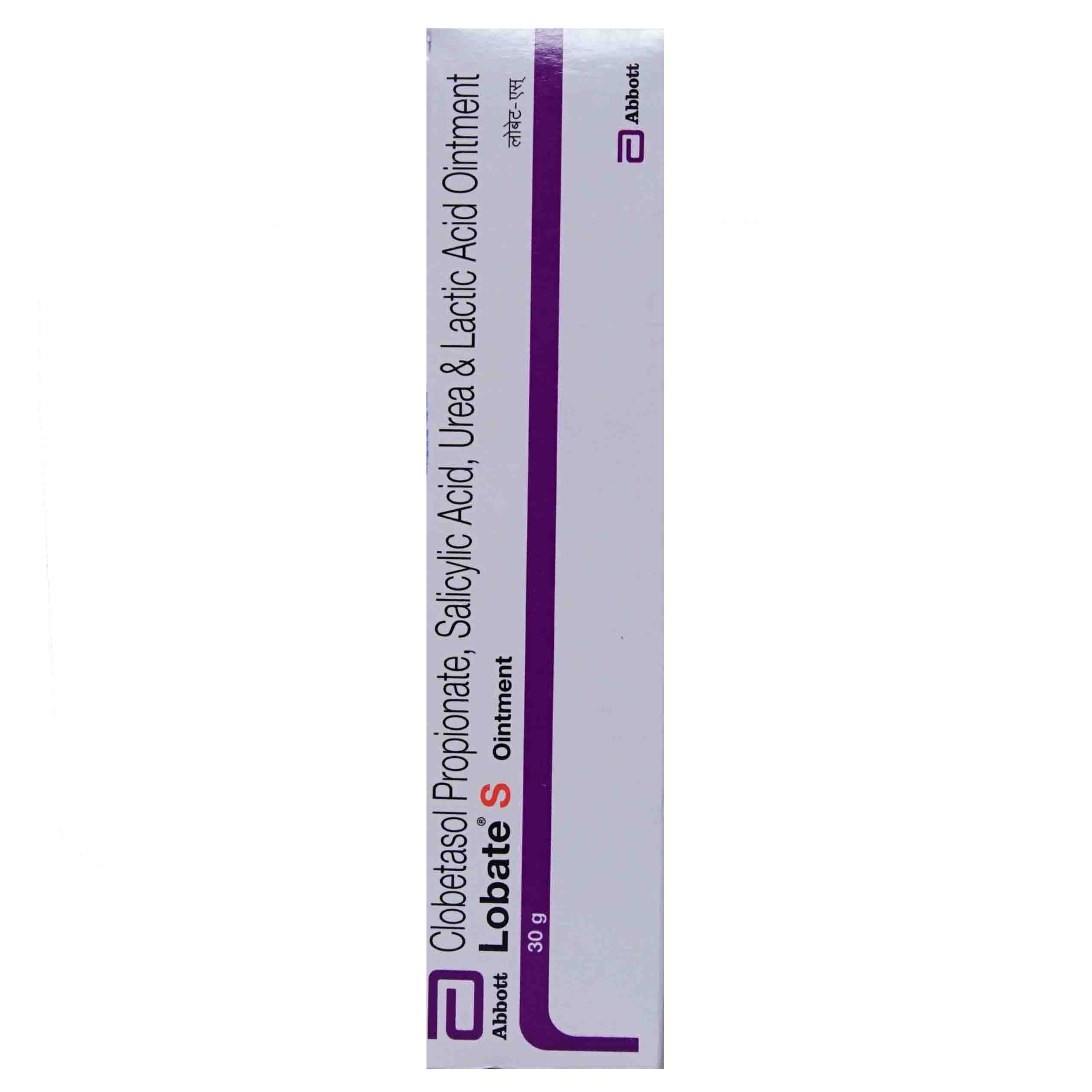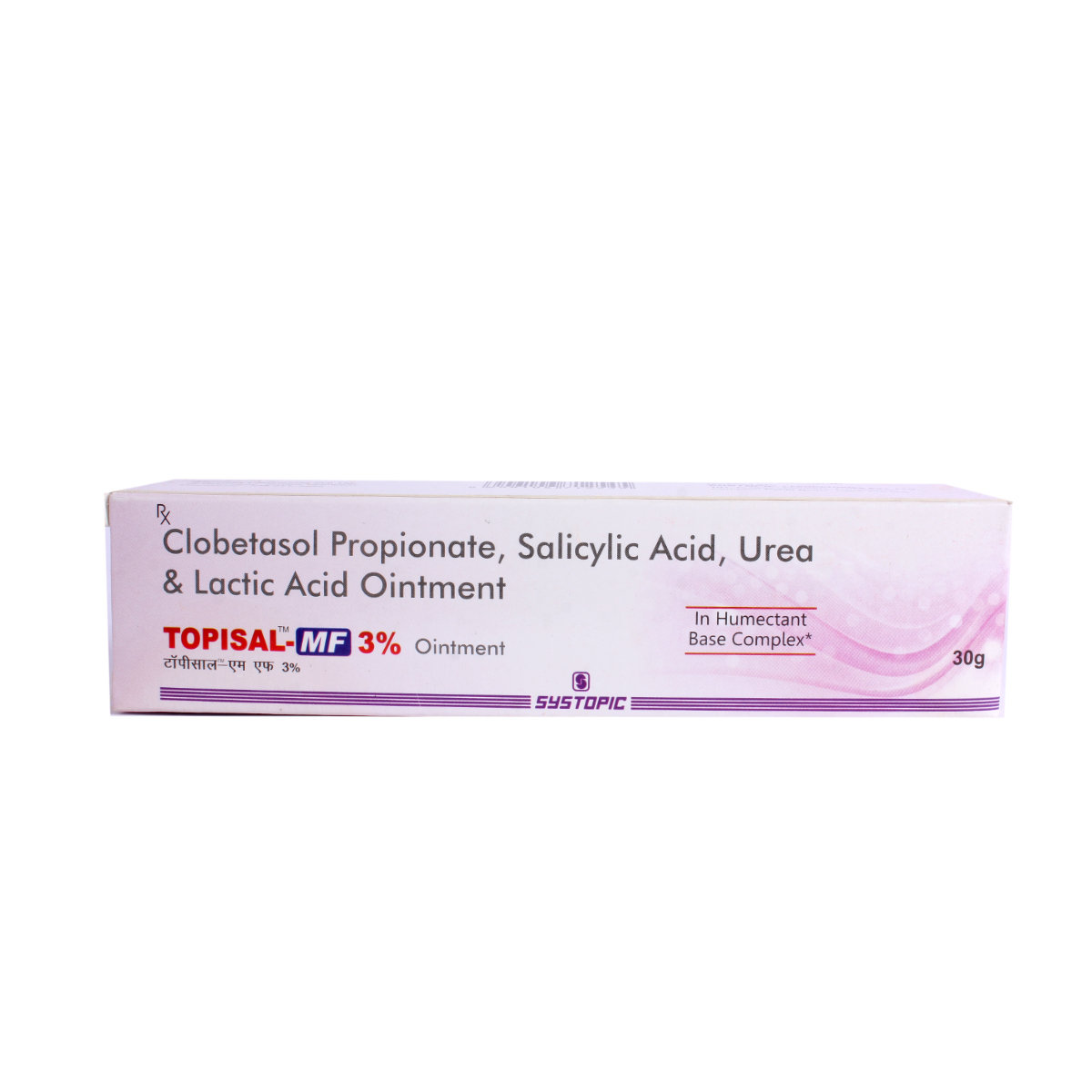Clobetasol+lactic Acid+salicylic Acid+sodium Lactate+urea
About Clobetasol+lactic Acid+salicylic Acid+sodium Lactate+urea
Clobetasol+lactic Acid+salicylic Acid+sodium Lactate+urea is a combination medicine used to treat psoriasis and eczema. Psoriasis is an autoimmune disorder in which skin cells multiply faster than usual, leading to a build-up of skin into bumpy (uneven) red patches covered with white scales. Eczema is generally known as skin inflammation which causes patches of itchy, inflamed, swollen, and cracked skin.
Clobetasol+lactic Acid+salicylic Acid+sodium Lactate+urea contains Clobetasol, Lactic acid, Salicylic acid, Sodium lactate, and Urea. Clobetasol works by inhibiting the release of chemical messengers that cause inflammation and redness. Salicylic Acid and urea help soften the skin by removing the dead skin cells and breaking down the keratin lumps. Lactic acid and sodium lactate prevent the skin from becoming dry and flaky by replenishing the moisture. Together, Clobetasol+lactic Acid+salicylic Acid+sodium Lactate+urea helps in treating psoriasis and eczema.
You are advised to use Clobetasol+lactic Acid+salicylic Acid+sodium Lactate+urea for as long as your doctor has prescribed it for you, depending on your medical condition. In some cases, you may experience certain common side effects, such as itching, irritation, and redness. Most of these side effects do not require medical attention and will resolve gradually over time. However, you are advised to talk to your doctor if you experience these side effects persistently.
Avoid using Clobetasol+lactic Acid+salicylic Acid+sodium Lactate+urea on infected or broken skin. Do not use Clobetasol+lactic Acid+salicylic Acid+sodium Lactate+urea if you had a skin reaction or irritation to any steroid medicine. Consult your doctor if you are pregnant or breastfeeding. Do not use Clobetasol+lactic Acid+salicylic Acid+sodium Lactate+urea in more than prescribed doses or on a large skin area for a longer duration, as it may cause adverse effects. Do not wrap or cover the treated area with a bandage unless advised by your doctor. Clobetasol+lactic Acid+salicylic Acid+sodium Lactate+urea is not recommended for children.
Uses of Clobetasol+lactic Acid+salicylic Acid+sodium Lactate+urea
Medicinal Benefits
Clobetasol+lactic Acid+salicylic Acid+sodium Lactate+urea is a combination of five drugs: Clobetasol, Lactic acid, Salicylic acid, Sodium lactate, and Urea. Clobetasol+lactic Acid+salicylic Acid+sodium Lactate+urea is used to treat psoriasis and eczema. Clobetasol is a steroid that works by inhibiting the release of chemical messengers that cause inflammation and redness. Salicylic acid is a keratolytic/peeling agent, and urea is an emollient. They help in softening the skin by removing the dead skin cells and breaking down the keratin lumps. Lactic acid and sodium lactate act as humectants; they prevent the skin from becoming dry and flaky by replenishing the moisture. Together, Clobetasol+lactic Acid+salicylic Acid+sodium Lactate+urea helps in treating psoriasis and eczema.
Directions for Use
Storage
Side Effects of Clobetasol+lactic Acid+salicylic Acid+sodium Lactate+urea
- Itching
- Irritation
- Redness
- Burning sensation
Drug Warnings
Do not use Clobetasol+lactic Acid+salicylic Acid+sodium Lactate+urea if you are allergic to any of the components. Inform your doctor if you have/had skin reaction or irritation to any steroid medicine; if you are using other medicines containing steroids, if you have glaucoma, cataracts, adrenal gland disorder, diabetes, kidney or liver disease. Consult your doctor if you are pregnant or breastfeeding. Clobetasol+lactic Acid+salicylic Acid+sodium Lactate+urea is not recommended for children. Do not use Clobetasol+lactic Acid+salicylic Acid+sodium Lactate+urea in more than prescribed doses or on a large skin area for a longer duration, as it may cause adverse effects. Do not wrap or cover the treated area with a bandage unless advised by your doctor. Avoid using Clobetasol+lactic Acid+salicylic Acid+sodium Lactate+urea on infected or broken skin.
Drug Interactions
Drug-Drug Interactions: No interactions found/established.
Drug-Food Interactions: No interactions found/established.
Drug-Disease Interactions: No interactions found/established.
Drug-Drug Interactions Checker List:
Safety Advice

Alcohol
cautionIt is not known whether Clobetasol+lactic Acid+salicylic Acid+sodium Lactate+urea interacts with alcohol. Please consult your doctor.

Pregnancy
cautionPlease consult your doctor if you have any concerns regarding this; your doctor will prescribe only if the benefits outweigh the risks.

Breast Feeding
cautionPlease consult your doctor if you have any concerns regarding this; your doctor will decide whether Clobetasol+lactic Acid+salicylic Acid+sodium Lactate+urea can be used by breastfeeding mothers or not. Do not apply Clobetasol+lactic Acid+salicylic Acid+sodium Lactate+urea on the chest if you are breastfeeding.

Driving
safe if prescribedClobetasol+lactic Acid+salicylic Acid+sodium Lactate+urea is unlikely to affect your ability to drive.

Liver
cautionPlease consult your doctor if you have any concerns regarding the usage of Clobetasol+lactic Acid+salicylic Acid+sodium Lactate+urea in patients with liver impairment.

Kidney
cautionPlease consult your doctor if you have any concerns regarding using Clobetasol+lactic Acid+salicylic Acid+sodium Lactate+urea in patients with kidney impairment.

Children
unsafeClobetasol+lactic Acid+salicylic Acid+sodium Lactate+urea is not recommended for children. Please consult a doctor if you have any concerns regarding this.
Habit Forming
Diet & Lifestyle Advise
- Eat foods rich in quercetin (a flavonoid) such as apples, cherry, broccoli, spinach, and blueberries.
- Consuming food rich in probiotics helps in developing the immune system against allergies.
- Limit intake of food that might trigger allergies, such as dairy products, soy, eggs, and nuts.
- Avoid consumption of foods with excess sugar as it may flare up inflammation.
- Include fruits, vegetables, whole grains, healthy fats, and fish in your diet.
- Reducing stress and maintaining a good sleep cycle would be helpful.
- Avoid getting in contact with harsh soaps, detergents, and rough fabrics.
Special Advise
- Clean and dry the affected area before using Clobetasol+lactic Acid+salicylic Acid+sodium Lactate+urea.
- Do not use Clobetasol+lactic Acid+salicylic Acid+sodium Lactate+urea on dressing, band-aids, and make-up unless told by the doctor.
- If Clobetasol+lactic Acid+salicylic Acid+sodium Lactate+urea comes in contact with eyes, nose, or mouth, rinse with water immediately.
- Wash your hands before and after using Clobetasol+lactic Acid+salicylic Acid+sodium Lactate+urea; however, do not wash your hands if you apply Clobetasol+lactic Acid+salicylic Acid+sodium Lactate+urea on your hands.
- Do not apply Clobetasol+lactic Acid+salicylic Acid+sodium Lactate+urea on wounds, cuts, damaged skin, or scrapes.
- Avoid exposing fabric that has been in contact with Clobetasol+lactic Acid+salicylic Acid+sodium Lactate+urea to smoke or naked flames.
Patients Concern
Disease/Condition Glossary
Psoriasis: Psoriasis is an autoimmune disorder in which skin cells multiply faster than usual, leading to skin build-up into bumpy (uneven) red patches covered with white scales. These most commonly appear on the scalp, elbows, knees, and lower back. Psoriasis is a chronic condition with no cure, but treatment aims to remove scales and stop skin cells from growing quickly. Triggers of psoriasis include infections, cold, and stress.
Eczema: Eczema, also known as atopic dermatitis, is a condition that causes patches of itchy, inflamed, swollen skin. It could occur due to stress, hormonal changes, irritating substances, food allergies, upper respiratory tract infections, or chemicals found in detergents. Symptoms of eczema include itching, red patches, bumps, and scaly skin.
FAQs
Clobetasol+lactic Acid+salicylic Acid+sodium Lactate+urea contains Clobetasol, Lactic acid, Salicylic acid, Sodium lactate, and Urea. Clobetasol works by inhibiting the release of chemical messengers that cause inflammation and redness. Salicylic Acid and urea help soften the skin by removing the dead skin cells and breaking down the keratin lumps. Lactic acid and sodium lactate prevent the skin from becoming dry and flaky by replenishing the moisture. Together, Clobetasol+lactic Acid+salicylic Acid+sodium Lactate+urea helps in treating psoriasis and eczema.
Clobetasol+lactic Acid+salicylic Acid+sodium Lactate+urea contains a steroid; therefore, it should not be used for longer durations unless prescribed by a doctor. If your condition does not improve despite using Clobetasol+lactic Acid+salicylic Acid+sodium Lactate+urea for 2-4weeks, consult your doctor, he/she may prescribe you an alternate medicine.
Avoid concomitant use of Clobetasol+lactic Acid+salicylic Acid+sodium Lactate+urea with other topical products such as cosmetics, sunscreens, lotions, moisturisers, insect repellent creams, and other gels.
Do not cover the treated skin with dressings after applying Clobetasol+lactic Acid+salicylic Acid+sodium Lactate+urea unless told by the doctor. Covering the skin can increase the amount of medicine absorbed through the skin leading to harmful effects.
Continue using Clobetasol+lactic Acid+salicylic Acid+sodium Lactate+urea for as long as your doctor has prescribed it. Do not be reluctant to speak with your doctor if you experience any difficulty while using Clobetasol+lactic Acid+salicylic Acid+sodium Lactate+urea.
Clobetasol+lactic Acid+salicylic Acid+sodium Lactate+urea contains a steroid; it can cause increased blood glucose levels. Therefore, consult a doctor before using Clobetasol+lactic Acid+salicylic Acid+sodium Lactate+urea if you have diabetes. Regular monitoring of blood glucose levels while using Clobetasol+lactic Acid+salicylic Acid+sodium Lactate+urea is advised.




